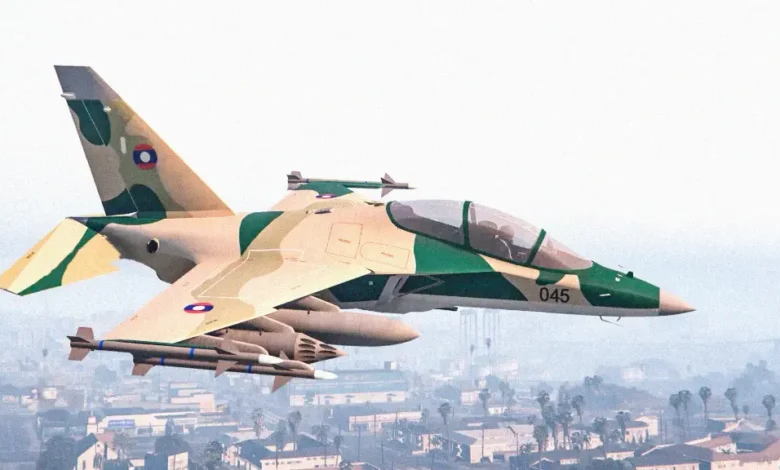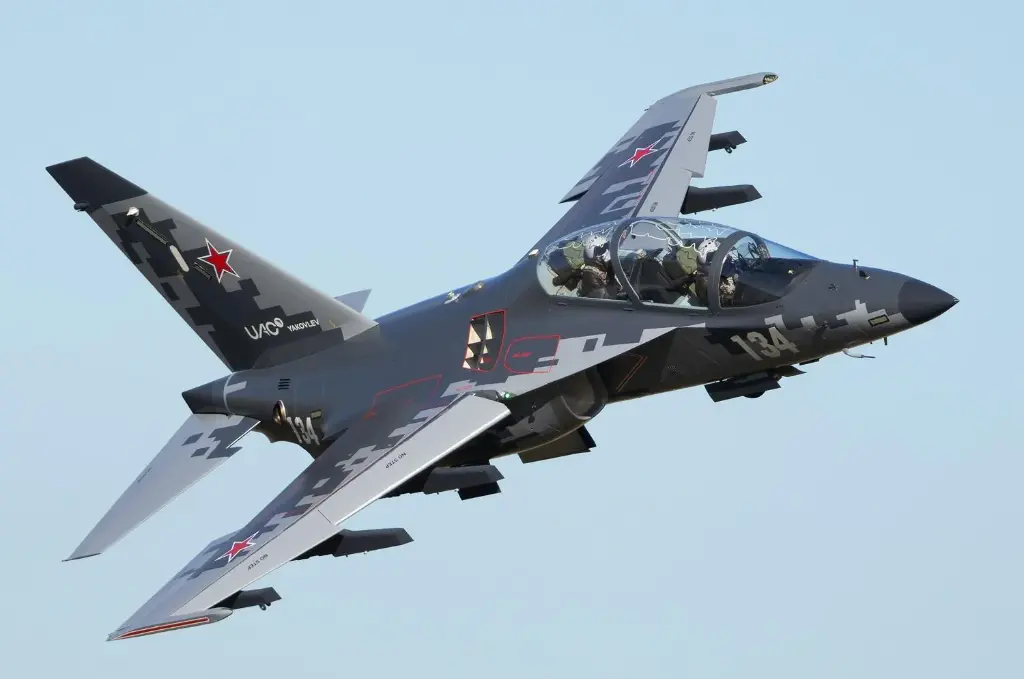Yakovlev Yak-130

The Yakovlev Yak-130 is a subsonic advanced jet trainer and light attack aircraft developed by Yakovlev and the Irkut Corporation for the Russian Air Force. First flown in 1996 and introduced in 2010, the Yak-130 is designed to provide pilot training for fourth- and fifth-generation fighters while also being capable of performing light attack and reconnaissance missions. Its versatility and modern avionics make it a valuable asset for both training and combat roles.
Fact Sheet
| Role | Advanced jet trainer and light attack aircraft |
|---|---|
| Manufacturer | Yakovlev / Irkut Corporation |
| First Flight | 1996 |
| Service Entry | 2010 |
| Crew | 2 (pilot and instructor) |
Specifications
| Length | 11.49 m (37 ft 8 in) |
|---|---|
| Wingspan | 9.72 m (31 ft 11 in) |
| Height | 4.76 m (15 ft 7 in) |
| Empty Weight | 4,600 kg (10,141 lb) |
| Max Takeoff Weight | 10,290 kg (22,692 lb) |
| Powerplant | 2 × Ivchenko-Progress AI-222-25 turbofans |
| Thrust | 5,511 lbf (24.5 kN) per engine |
| Max Speed | Mach 0.93 (1,060 km/h; 660 mph) |
| Service Ceiling | 12,500 m (41,000 ft) |
| Range | 1,240 mi (2,000 km) with drop tanks |
| Rate of Climb | ~33,000 ft/min (168 m/s) |
Avionics & Armament
| Main Radar | Optional radar for light attack roles |
|---|---|
| Avionics | Modern avionics suite, glass cockpit |
| Armament | Up to 3,000 kg (6,600 lb) of ordnance on 9 hardpoints, including: – Air-to-air missiles (R-73) – Air-to-ground munitions (bombs, rockets) – Gun pods – External fuel tanks |
Notable Features
- Dual-role capability for training and light attack missions.
- Advanced avionics for simulating fourth- and fifth-generation fighters.
- High maneuverability for effective pilot training.
- Cost-effective solution for air forces with limited budgets.
- Widely exported to allied nations for training and combat roles.

The Yakovlev Yak-130 (NATO reporting name: Mitten) is a state-of-the-art subsonic two-seat advanced jet trainer and light combat aircraft developed by Russia’s Yakovlev Design Bureau. It was designed to replace older Soviet-era trainers like the L-29 Delfin and L-39 Albatros, providing a highly capable and cost-effective platform for pilot training and, crucially, for simulating the flight characteristics of modern 4th and 5th-generation combat aircraft.
Development and Design Philosophy
Development of the Yak-130 began in the early 1990s as the Soviet Union sought a new advanced trainer. Initially, Yakovlev partnered with the Italian company Aermacchi on the “Yak/AEM-130” joint program. However, this collaboration eventually ended in 2000, with both companies pursuing independent designs: Yakovlev continued with the Yak-130, while Aermacchi developed the M-346 Master, which shares a common design lineage.
The Yak-130 made its maiden flight on April 25, 1996, and was officially chosen as the winner of the Russian Air Force’s trainer competition in 2002. It entered service with the Russian Air Force in 2010.
The core philosophy behind the Yak-130 is its ability to serve as a Lead-in Fighter Trainer (LIFT), preparing pilots for complex modern combat aircraft. It achieves this through:
- Advanced Fly-by-Wire (FBW) System: A fully digital, four-channel FBW system allows the aircraft’s stability and controllability characteristics to be adjusted to mimic those of various combat jets, including the Su-30, MiG-29, F-15, F-16, Eurofighter, F-22, and F-35. This greatly reduces the transition time and cost for pilots moving to more advanced platforms.
- “Glass Cockpit” and Modern Avionics: The cockpit features an all-digital, open-architecture avionics suite compliant with MIL-STD-1553, complete with three large multi-function color liquid crystal displays (LCDs) in each cockpit. Both pilot positions are Night Vision Goggle (NVG) compatible and include a Head-Up Display (HUD) in the front and a helmet-mounted targeting system, closely replicating the environment of advanced combat aircraft.
- Dual-Role Capability: Beyond its primary training role, the Yak-130 is marketed and used as a light combat aircraft. It can carry a significant payload of weapons and has limited reconnaissance capabilities.
Key Features and Capabilities
- Twin Engines: Powered by two Ivchenko-Progress AI-222-25 turbofan engines (with an upgraded -28 version also available), each providing approximately 2,500 kgf (5,510 lbf) of thrust. This twin-engine setup provides redundancy and contributes to good performance and reliability.
- Aerodynamics: Features a classic swept-wing monoplane design with prominent leading-edge root extensions (LERXs) and a moderately swept high-lift wing, enabling stable controlled flight at high angles of attack (up to 40 degrees).
- Rugged Design: Designed for a 30-year service life with 10,000 to 15,000 flight hours and 20,000 landings. Its robust landing gear and engine intake protection systems (closing main intakes and opening upper louvers on the LERXs) allow it to operate from unpaved runways and small, unprepared airfields.
- Armament: The Yak-130 can carry up to 3,000 kg (6,614 lbs) of combat load on its nine hardpoints (two wingtip, six underwing, and one under-fuselage). This can include:
- Air-to-Air Missiles: Primarily R-73 (infrared-guided).
- Air-to-Surface Missiles: Such as Kh-25ML (laser-guided).
- Rockets: Various unguided rocket pods (e.g., 80mm S-8, 122mm S-13, 240mm S-25).
- Bombs: Free-fall bombs (e.g., KAB-500Kr TV-guided bombs, FAB-250/500, ZAB-500 incendiary bombs).
- Gun Pods: An external 23mm GSh-23-L cannon pod can be carried under the fuselage.
- Other Pods: Electronic warfare (ECM) pods, reconnaissance pods, and external fuel tanks.
- Radar (Optional): While primarily a trainer, some variants can be fitted with radar such as the Kopyo-21I or Kopyo-M (or potentially the BARS-130 radar, capable of detecting air targets at 85 km and ground targets with SAR capabilities), expanding its light combat role.
- Training System Integration: The Yak-130 is the core component of a comprehensive Integrated Training System (ITS) that includes ground-based simulators, computer classrooms, and mission planning tools, allowing for up to 80% of pilot training to be conducted without using actual combat aircraft.
Operators and Combat History
The Yak-130 has been successfully exported to several countries:
- Russia (Russian Aerospace Forces): The primary operator, using the Yak-130 for both advanced pilot training and light attack/reconnaissance roles.
- Algeria
- Bangladesh: Has reportedly lost several aircraft in training accidents.
- Belarus: Has reportedly suffered some losses, including one in 2021 where both pilots died after a crash in Baranavichy.
- Laos
- Myanmar: Has actively employed the Yak-130 in its light attack role during the ongoing civil conflict, using it to fire unguided rockets and cannons on and around civilian-populated areas.
- Vietnam
Combat History: While primarily a trainer, the Yak-130 has seen actual combat use as a light attack aircraft, most notably by the Myanmar Air Force in its internal conflict. Footage and reports indicate its use in ground attack missions with unguided rockets and cannon fire.
Future and Significance
The Yakovlev Yak-130 is a modern and versatile aircraft that fills a critical niche for air forces worldwide. It offers a cost-effective solution for training pilots for complex 4th and 5th-generation fighters, while also providing a credible light attack capability. Its advanced systems and adaptability ensure its continued relevance as a valuable asset for both training and limited combat operations for many years to come.



